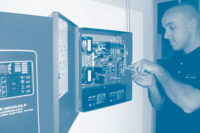

The most difficult aspect of running a security company isn’t usually the technology — it’s making sure the business is profitable. Security company executives say protecting profit margins is their greatest challenge over the next three years, according to SDM’s 2008 Forecast Study.
In recent years, a number of factors have combined to make it more challenging than ever to operate profitably. As access control, video surveillance and other security equipment increasingly uses the Internet protocol (IP) for communications, the security business has begun to attract new competition from integrators that are more information technology (IT) and networking oriented — and who are accustomed to working with lower margins on equipment sales. As a result, the margins on physical security systems have been declining.
“It wasn’t uncommon a decade ago to see a systems integrator with a 50 percent margin,” recalls Bill Bozeman, president and CEO of the Professional Security Alliance (PSA), headquartered in Westminster, Colo. “Those days are over. Margins have dropped from 50 to 45 to 40 to 35.
“In general, the smaller the project, the higher the margin,” Bozeman concedes. “I’ve seen some large projects with some scary margins — in the low teens or even less.”
As Bozeman explains, “Physical security grew up in a world where you make your money on the front end. But network integrators’ profitability comes on the back end. It’s not unusual to see a router or switcher marked up 10 percent, and network integrators are bringing this mentality to the physical security business, which is scary for the physical security integrator.”
Making matters worse, equipment prices have been declining — and with the help of the Web and powerful search engines, end users have little difficulty determining the wholesale prices of products and demanding commensurate retail prices. “The Internet has created a situation where any purchasing agent or novice can check on the dealer price of a box,” Bozeman laments.
But along with challenges such as these come new opportunities. Even in such a price-conscious environment, there are some key performance measurements that security companies can use to help ensure their businesses operate profitably. And there are some promising options for security companies that are seeking to minimize or even reverse margin erosion and thrive in today’s market.
KEY METRICS
One company that has an insightful view on average margins is TSS International, a security consulting firm based in Trevose, Pa., that has compiled aggregate numbers based on the experiences of hundreds of clients.
The average gross margin on an access control or video installation job today is between 31 and 32 percent, says John Nemerofsky, president of TSS International. Gross margins measure the profitability of a job before overhead is deducted.
But the margin on a specific job may depend on the technology installed. “Usually access control jobs are more profitable than video,” Nemerofsky comments. Because it typically is easier to install, video is much more of a commodity, he says. “Access control, because there is software involved, is still more difficult.”
As senior consultant, financial strategies for Sandra Jones & Company, a Chardon, Ohio-based consulting firm specializing in the security industry, Raymond Lynn frequently consults with security companies seeking to improve their profitability. Two of the most critical performance indicators that contribute to overall profitability, he says, are installer efficiency and installation overhead.
Installer efficiency is a measurement of how many hours out of a 40-hour work week an installer actually spends on a job. Noting that some time always will be eaten up in travel, Lynn says, “Somewhere around 90 percent is pretty good. If you’re somewhere around 30 percent, you have a problem.”
He notes, for example, that if a company pays an installer $25 an hour, it should bill that installer’s labor at a higher rate that includes the cost of travel. “If your installer efficiency is low, that number will be higher,” he says.
Ensuring that billing procedures cover a company’s overhead is also critical. Lynn recommends companies review their actual overhead costs on a quarterly basis to ensure that those costs are adequately covered through billings to customers. If they don’t, he cautions, that oversight can have a compounding effect because salespeople are paid on margin – and if margins have not been calculated correctly, salespeople can be overcompensated.
The good news, Lynn says, is that none of his recommendations are difficult to implement. Companies go astray not because they are incapable of accurate financial measurement, but rather because they get caught up in day-to-day operations and neglect to properly track performance.
Like Lynn, David Carter, managing director for Security Networking Alliance (SNA) of Southern Pines, N.C., also has spent a lot of time analyzing security company profit margins. Although SNA member companies traditionally have focused on alarm systems, they also do video surveillance and access control work — and for SNA members those jobs have been increasing as a percentage of total revenues.
One of the services SNA offers members is SNAPS (for SNA Partner Survey), a quarterly performance measurement system that ranks members on about 150 criteria. As Carter explains, this information is used to enhance performance. “You can put somebody that’s top in a category with people who are farther down to show them how best practices can enable them to move up.” For example, he says, a company with a high rating for installer efficiency might reveal that its installers were able to do more service calls by using a global positioning system to find the best route to each customer location.
OPPORTUNITIES
The shift towards an IT environment in the security business may not be such a bad thing, says Dan Dunkel, president of Dallas-based New Era Associates, a security industry consulting firm, as well as author of SDM’s monthly Integration Intelligence column. As Dunkel points out, a typical IT department will have a budget that is 10 times the size of the company’s security budget.
Looking at a typical IT budget in more detail, Dunkel observes that about two-thirds of it goes for networking and storage. The good news there, he says, is that storage often can be sold at relatively high margins and could be a lucrative opportunity for security companies.
He advises security companies to move away from their emphasis on digital video recorders and instead adopt more of an IT storage architecture. “For every five DVRs, if you sold storage instead, your margin would actually improve,” he says. “You could save $10,000 for five DVRs.”
Bozeman also advises security companies to structure their business more like IT integrators, who make their highest margins on the back end through software upgrades and remote services.
“Way too many physical security integrators install a job and walk away,” Bozeman says. Recently, the technology to remotely monitor video surveillance systems has become more prevalent, and he encourages security companies to sell such services.
Another possibility, Bozeman says, is to structure deals so customers pay a monthly fee that includes monitoring, maintenance and software upgrades and equipment. Noting that cellular companies and satellite service providers build equipment costs into a monthly fee, Bozeman says, “Integrators that adopt that model are positioned to be very profitable in the future.”
RECURRING REVENUE
A new standard from the National Fire Protection Association could make it easier for security companies to sell maintenance agreements, says Nadim Sawaya, president of Enterprise Performance Consulting of Pittsburgh, Calif. As Sawaya describes, the NFPA 731 standard – which covers a wide range of electronic security systems – specifies testing and preventive maintenance that end users must do. The standard is not fully adopted yet, but when it is, Sawaya says, “There’s an opportunity for integrators to make additional money by doing preventive maintenance.”
Security companies also should borrow some practices from the IT discipline that can help ensure profitability, Sawaya advises. “It’s important to adopt a project-style culture” in which security companies “have to learn to do it right the first time,” he says. For example, Sawaya advises companies to do pre-engineering drawings and have them approved before starting any field work.
Another way to keep margins high is to subcontract routine tasks, such as installing wire.
Sawaya believes that recurring monthly revenue (RMR) today accounts for less than 10 percent of revenues for the typical security integrator. He would like to see that number climb into the 25 percent range.
Nemerofsky points out another benefit of higher RMR. As he explains, the money earned on an installation typically follows a bell curve, with a small amount of billing near the beginning of the project that swells to a peak when equipment is delivered and then tapers off. “RMR flattens out the bell curve,” Nemerofsky explains.
He offers some advice for boosting profits on the upfront installation: The more specialized a job is, the fewer competitors — and higher profit — a company is likely to see.
“If you’re just putting in access control, there’s a lot of competition,” Nemerofsky observes. “If you integrate it with video, there’s a bit less. If you do all that plus install a smart card system, there’s a little less. And if there’s middleware or a command-and-control interface, there’s even less.”
A command-and-control interface overlays a graphical user interface onto an integrated system and helps create policies to make the system easier for security officers to operate. As Nemerofsky explains, policies provide answers to questions such as “If this door trips and this camera comes up, what do I do?”
There is not one key, but many to open the door to better profit margins: Specialize your projects as much as possible to lock out competition; observe, analyze and implement IT integrator business models when possible; measure costs and overhead regularly and adjust them when necessary; and introduce new services that create new revenue streams, especially recurring revenue.

